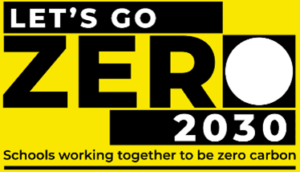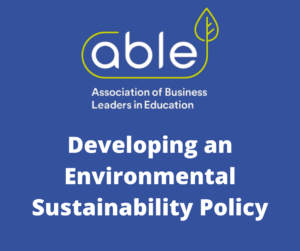Robin Harrison, Facilities & Resources Manager at Rushcliffe Spencer Academy and a Fellow of the Institute of School Business Leadership, explores how a realistic School Environmental Policy and associated Action Plan can make a difference.
 In October 2021 the UK Government issued the Net Zero Strategy: Build Back Greener, which indicates that “schools and colleges will play a vital role delivering high-quality education and training to equip young people with the knowledge and skills required for the green economy. This will help to grow the pipeline of skilled workers needed to help deliver the net-zero transition.”
In October 2021 the UK Government issued the Net Zero Strategy: Build Back Greener, which indicates that “schools and colleges will play a vital role delivering high-quality education and training to equip young people with the knowledge and skills required for the green economy. This will help to grow the pipeline of skilled workers needed to help deliver the net-zero transition.”
 At the recent COP26 United Nations Climate Change Conference, the government announced that in April 2022 the Department for Education will publish a Sustainability and Climate Change Strategy for the education and children’s services sectors. The strategy will deliver against four strategic aims:
At the recent COP26 United Nations Climate Change Conference, the government announced that in April 2022 the Department for Education will publish a Sustainability and Climate Change Strategy for the education and children’s services sectors. The strategy will deliver against four strategic aims:
1. Excellence in education and skills for the changing world, preparing all young people for a world impacted by climate change through learning and practical experience.
Net Zero reducing direct and indirect emissions for education and care buildings, driving innovation to meet legislative targets and providing opportunities for children and young people to engage practically with the net-zero concept.
Resilient to Climate Change adapting to mitigate against the worst impacts of climate change in our education and care buildings and infrastructure.
A better environment for future generations enhancing biodiversity and increasing access to nature in and around education and care settings
Whilst many schools are already doing much to support environmental sustainability, few have fully captured and documented what they are doing. Two documents are key to this, and School Business Leaders are ideally placed to support the process.
School Environmental Sustainability Policy
This document sets out the key policy positions, and explains to staff, pupils and parents the core sustainability beliefs and ethos of the school. Whilst each school has its own unique circumstances, this is the structure deployed at Rushcliffe Spencer Academy:
An introduction defines what is meant by environmental sustainability including the following:
-Mitigating undesirable impacts on climate, health, biodiversity, environmental quality, and resource depletion;
-Legal and statutory compliance (e.g. Control of pollution Act 1974, Climate Change Act 2008 and others);
-Management of costs through effective resource management and efficient use of utilities;
-Increased organizational resilience e.g. to floods and adverse weather;
-Emerging changes to local and central government policy, tightening planning permission requirements
-Moral imperative – it is simply the right thing to do.
This is linked to the policy to the school’s core values. Rushcliffe Spencer Academy added a new core value – “We care for our world”.
A definitions section followed – explaining what is meant by phrases such as “carbon footprint”, “Net-zero”, and the like.
A responsibilities section sets out clear roles for all members of the school community, including the Head, Site Team, Subject Leaders, Pupils, Eco Team Leader.
A policies section describes what the school policy is in relation to a number of headings, more of which later in the article. Examples under the Managing Sustainability policy section could include, for example,
-The school shall work towards being Net-Zero carbon neutral in accordance with GHP Scope 3 by 2050 in alignment with the Governments ambition for the United Kingdom to be carbon net-zero by 2050.”
-The school shall implement an Environmental and Sustainability Action Plan.
-The school shall maintain an Eco Team consisting of staff and pupils to engage pupils in sustainability issues.
-The school will work towards retaining Eco School Green Flag status.
-The school will embed the teaching of environmental sustainability issues across the curriculum.
-The school will communicate its progress towards environmental sustainability to staff, pupils, parents and carers, and to the wider local community.
The school has specific policies under headings relating to School buildings and grounds, biodiversity, energy use, global citizenship, healthy living, waste and litter management, transport and travel, water and marine, and purchasing. These align strongly with the strands considered by Eco-Schools.
There are sections for Policy Review and signatures.
Environmental Sustainability Action Plan
This document is a living working tool, constantly evolving, and constantly updated as progress is made. Do take every opportunity to publicise successes along the way – it will encourage others to make further progress.
Every school will be on a different stage on the sustainability journey, and it will be practically impossible to get everything right straight away. The important thing is to concentrate effort on the easy wins, and give yourself recognition for the things that are already being done well and are embedded into the way the school operates, whilst identifying achievable smart targets to work on for the coming year.
As with any journey, it is useful to understand the starting point. The Rushcliffe Spencer Academy Environmental Sustainability Action Plan starts with a section on historic utilities performance data. Chosen to mirror the data provided under the Government’s Streamlined Energy and Carbon Reporting (SECR) methodology.
The next section is a summary of priorities to be targeted in the current academic year. These are lifted from the more detailed action plan headings that follow, and help to focus action on achievable smart objectives. Examples from the Rushcliffe Spencer Academy priorities for 2021/22 include:
-Management – establish our carbon baseline based on 2020/21 financial data;
-Building and grounds – create a woodland area to improve biodiversity;
-Energy – complete the conversion of lighting to LED;
-Waste and litter – eliminate single-use plastic drinks bottles by alternative purchasing and promotion of refillable bottles;
-Purchasing – all photocopy paper to be either recycled stock from Forestry Stewardship Council certified sources.
The Action Plan itself follows. It is recognised that the journey towards improved environmental sustainability is a continuously evolving one and that it is not always possible to move forwards on all strands all the time or at the same pace. What can be achieved will depend on a wide variety of resources, including but not limited to staff and pupil availability, access to funding, and the range and variety of external opportunities that become available.
Action Plan Strands address themes relating to sustainability. Rushcliffe Spencer Academy identified nine areas, each to have its own action plan.
- Managing Sustainability. Ensuring that the school has the ethos, policies, procedures, and skills to ensure that sustainability issues are managed in an effective manner. This helps to ensure that sustainability issues are embedded within the culture.
- School buildings and grounds including biodiversity. Biodiversity refers to the variety of plant and animal life in the world or in a particular habitat, a high level of which is considered to be important and desirable. The school site and grounds provide a visually attractive environment inhabited by wildlife and plants and potentially provides an important environmental teaching resource.
- Energy Use. Energy use needs to be efficiently managed to avoid excessive fuel use while maintaining appropriate and safe heating and lighting levels. Over time it is considered desirable to reduce so far as reasonably practical the school’s dependence on carbon-intensive fossil fuels, subject to available funding for decarbonisation strategies.
- Global citizenship. A global citizen is someone who is aware of and understands the wider world – and their place in it. They take an active role in their community and work with others to make our planet more peaceful, sustainable, and fairer. Global citizenship is all about encouraging young people to develop the knowledge, skills, and values they need to engage with the world, and about the belief that everyone can make a difference. Education for global citizenship is a framework for learning, reaching beyond school to the wider community. It can be promoted in class through the existing curriculum or through new initiatives and activities. Global citizenship is also about recognising that the lifestyles led and the resources consumed are often dependent upon the products and services of worldwide communities.
- Health Living. Healthy Living refers to the choices that individuals make regarding how they live their lives in a way that promotes and supports good health, physical fitness and emotional wellbeing. Catering and dietary choices can also impact the school’s carbon footprint. Schools can support staff and pupils to make informed decisions regarding diet, exercise, and social habits and behaviours.
- Waste & Litter Management. How waste is managed can have a considerable environmental impact.
- Water & Marine. The quality of the marine environment can be affected by what resources schools use that are derived from the marine environment, for example, fish used in catering. The marine environment can also be affected by materials discharged into waste and into watercourses by the school. Rainwater that falls on the school site discharges into local streams and then into the local rivers and eventually into the sea. Plastic waste derived on the school site can over time break down into microplastic particles which can also find their way into watercourses and then out to sea. Marine microplastics are now understood to be a significant source of pollution and have a harmful effect on sea life and on the subsequent food chain. Reducing the amount of mains water that the school consumes reduces the demand for upstream water processing and transmission and downstream foul water processing, and reduces mains water supply costs.
- Transport & Travel. Sustainable transportation is the capacity to support the mobility needs of a society in a manner that is the least damaging to the environment and does not impair the mobility needs of future generations. The use of fossil-fuelled vehicles is a major contributor to CO2 and particulate emissions, impacting air quality and on health. Decarbonizing transportation aims to reduce, mitigate, and even eliminate carbon emissions by adapting transportation infrastructures, conveyances, and operations.
- Procurement of goods materials and services used by schools can account for around 40% of a school’s carbon footprint. Sustainable purchasing is also about minimising the negative social environmental and economic impacts of our purchasing decisions.
The structure of the action plan format below allows themes and actions to be identified for future action. Progress over time, captured by periodic policy review, will allow themes and actions to progress through the stages until they become embedded.
| Litter & Waste Management: | ||||||
| What are we doing well? | ||||||
| Item/Issue | What is the evidence? | What needs to happen next? | When? | Who By? | Completed? | Date |
| e.g. Battery recycling | Battery recycling point located in school Reception | Continue | Ongoing | Reception Team | Ongoing | |
| What could we do better? | ||||||
| e.g. Reduce the quantity of litter dropped by pupils | Occasional excessive litter on school fields and catering areas after food service times | Pupil behaviour education – assemblies | Spring term | Year leaders | ||
| What have we not started to consider? | ||||||
| e.g. Chewing gum | Chewing gum appears on hard landscaped surfaces and on classroom furniture | Publicise chewing gum ban, enforce within behaviour management protocols | Ongoing | Form tutors | ||
It is helpful to link each action plan strand to a named Leadership Team member link. This supports effective oversight and links to the overall School Improvement Plan (SIP) and Estates Management Plan (EMP).
It takes time to develop the Action plan from a blank format to a meaningful document, but the outcome is well worth the time investment. Make time to review the plan regularly and update it whenever a challenge is completed, or a new idea emerges. Target some quick wins – it is important for the school community to see progress.
Robin Harrison is a long-standing member of the Association of Business Leaders in Education – ABLE. https://ablepro.info . Robin will be presenting a workshop at the ABLE spring conference on 9th March 2022 entitled Developing an Environmentally Sustainable Policy and Action Plan for your School.

